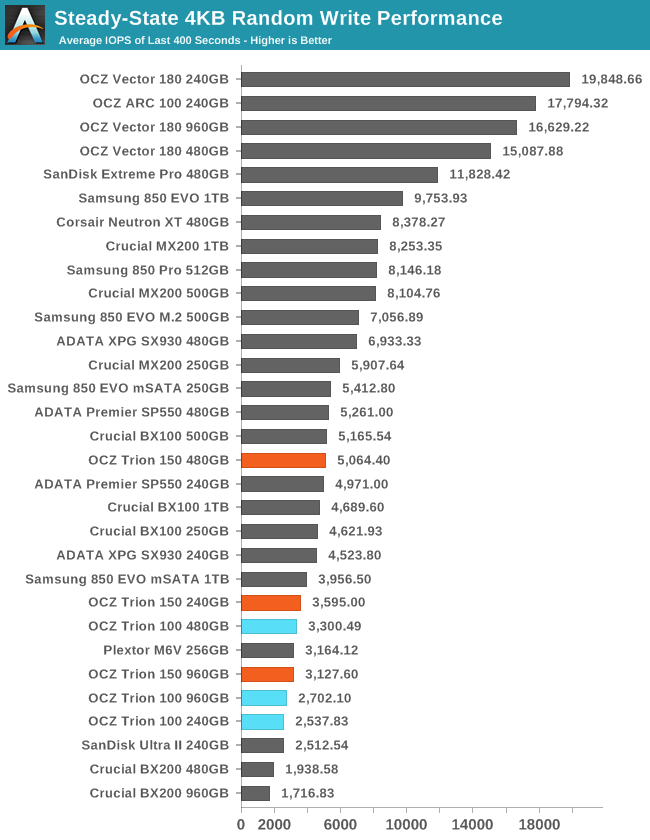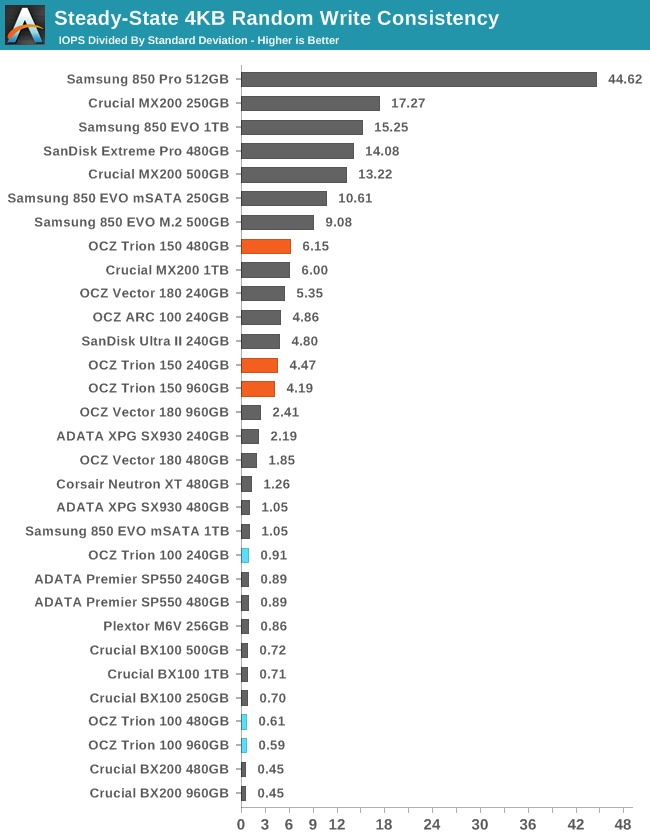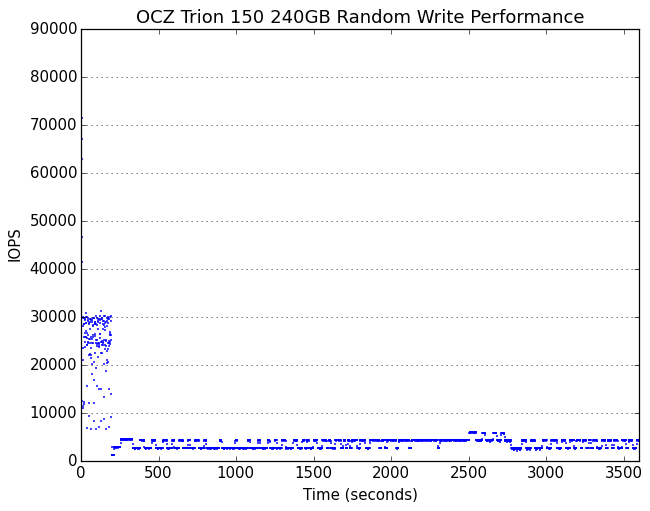The OCZ Trion 150 SSD Review
by Billy Tallis on April 1, 2016 8:00 AM ESTPerformance Consistency
Our performance consistency test explores the extent to which a drive can reliably sustain performance during a long-duration random write test. Specifications for consumer drives typically list peak performance numbers only attainable in ideal conditions. The performance in a worst-case scenario can be drastically different as over the course of a long test drives can run out of spare area, have to start performing garbage collection, and sometimes even reach power or thermal limits.
In addition to an overall decline in performance, a long test can show patterns in how performance varies on shorter timescales. Some drives will exhibit very little variance in performance from second to second, while others will show massive drops in performance during each garbage collection cycle but otherwise maintain good performance, and others show constantly wide variance. If a drive periodically slows to hard drive levels of performance, it may feel slow to use even if its overall average performance is very high.
To maximally stress the drive's controller and force it to perform garbage collection and wear leveling, this test conducts 4kB random writes with a queue depth of 32. The drive is filled before the start of the test, and the test duration is one hour. Any spare area will be exhausted early in the test and by the end of the hour even the largest drives with the most overprovisioning will have reached a steady state. We use the last 400 seconds of the test to score the drive both on steady-state average writes per second and on its performance divided by the standard deviation.

The Trion 150 substantially improves steady-state performance over its predecessor. The middle 480GB capacity is once again the best-performing size by a wide margin.

The Trion 150's consistency score has climbed out of the gutter—aided somewhat by the improved average performance, but there's clearly been a major change in behavior for the drive firmware that reduces the variability of write performance. The Trion 150 scores much better than any other budget drive.
 |
|||||||||
| Default | |||||||||
| 25% Over-Provisioning | |||||||||
After a very short initial burst of high performance due to SLC write caching, the Trion 150 settles into a pattern of decent but broadly variable performance as it burns through the remaining spare area. Once the spare area is exhausted the behavior changes completely and the drive is very steady, transitioning between a handful of discrete performance levels.
 |
|||||||||
| Default | |||||||||
| 25% Over-Provisioning | |||||||||
Looking closer at the steady-state phase, the transitions between performance states are very clear and abrupt, and there are no outliers in either direction. The performance with manual overprovisioning is substantially higher and the consistency is only slightly worse. In either case, the consistency is as good as we could ask for and a big improvement over the earlier Trion 100.










79 Comments
View All Comments
RBFL - Saturday, April 2, 2016 - link
What do you define as decent priced?xrror - Saturday, April 2, 2016 - link
The worst part I'm guessing is finding anything decently priced that isn't 1366x768. I hate that resolution so much. My keep looking to replace my old core2 craptop that wheezes along (sadly it uses the most gimped/market segmented version of the Intel 945GM chipset), But it uses an old school 1440x900 screen - and that vertical space I refuse to give up.Sorry folks, when I see 768 - that was only cool back when 1024x768 was an upgrade from VGA's 800x600. F going back.
Samus - Sunday, April 3, 2016 - link
Look at HP Elitebooks like the 820 and 840, they come standard with 1600x900 screens (which is a perfect resolution on the 12.5" 820.1920x1080 is fine and all on a 14"+ but really sucks on a 11-13" unless you have display scaling. Windows 7 and Linux it just sucks unless you have eagle vision.
BurntMyBacon - Monday, April 4, 2016 - link
@Samus: "Look at HP Elitebooks like the 820 and 840, they come standard with 1600x900 screens (which is a perfect resolution on the 12.5" 820."I do rather like that resolution for this size on a notebook. Tablets are generally used at a closer distance, but I digress.
@Samus: "1920x1080 is fine and all on a 14"+ but really sucks on a 11-13" unless you have display scaling. Windows 7 and Linux it just sucks unless you have eagle vision."
Yet I'd still rather see 1920x1080 than 1366x768 as I find it less frustrating to lean a little closer when I need to than to not be able to get the content I want on screen. Until better scaling is commonplace, 1680x1050 or 1600x900 please.
Arbie - Friday, April 1, 2016 - link
The link below is a 2011 review on Anandtech, showing Velociraptor scores vs SSDs of the time. You can estimate pretty well from that how things would compare now.FYI, the Mushkin Reactor 1TB MLC SSD (reviewed here recently) is available for $220 on NeweggBusiness.
http://www.anandtech.com/show/4337/z68-ssd-caching...
Samus - Sunday, April 3, 2016 - link
Excellent drive (the Mushkin Reactor) I have recommended it at least a dozen times and never heard a complaint. Stark contrast to the one person who didn't take my advice (I have two of them so I know how good they are) and bought the Sandisk Ultra II 960GB instead because it was $20 cheaper. It failed on them after 4 months. Which is alarmingly common if you read the reviews on Newegg.Ryan Smith - Friday, April 1, 2016 - link
"Second, would it be at all reasonable to add a WD VelociRaptor, Hybrid SSHD, and/or common 5400RPM hard drive to the 2015 SSD Bench like the old days?"It's definitely something we can look into. Keep in mind that we'd only be able to use them for a portion of the tests though; even a 7200 RPM drive would be impossibly slow on tests like the Destroyer that involve a lot of random activity.
BurntMyBacon - Monday, April 4, 2016 - link
@Ryan Smith: "It's definitely something we can look into. Keep in mind that we'd only be able to use them for a portion of the tests though; even a 7200 RPM drive would be impossibly slow on tests like the Destroyer that involve a lot of random activity."That is fine. The destroyer was made to tease out differences in performance and consistency between SSDs that are so high end that are hidden in lesser tests. One of your other (far less strenuous) tests is good enough as a reference point to show how HDDs stack with respect to random activity.
jsntech - Friday, April 1, 2016 - link
From a strictly business point of view, Toshiba should probably re-brand OCZ to some other name. Not a single member of my moderate circle of pro or power user friends will ever touch anything with OCZ in the name again. And they all told their friends, and they all told their friends, etc.Flunk - Friday, April 1, 2016 - link
I'd personally be happier with "Toshiba".